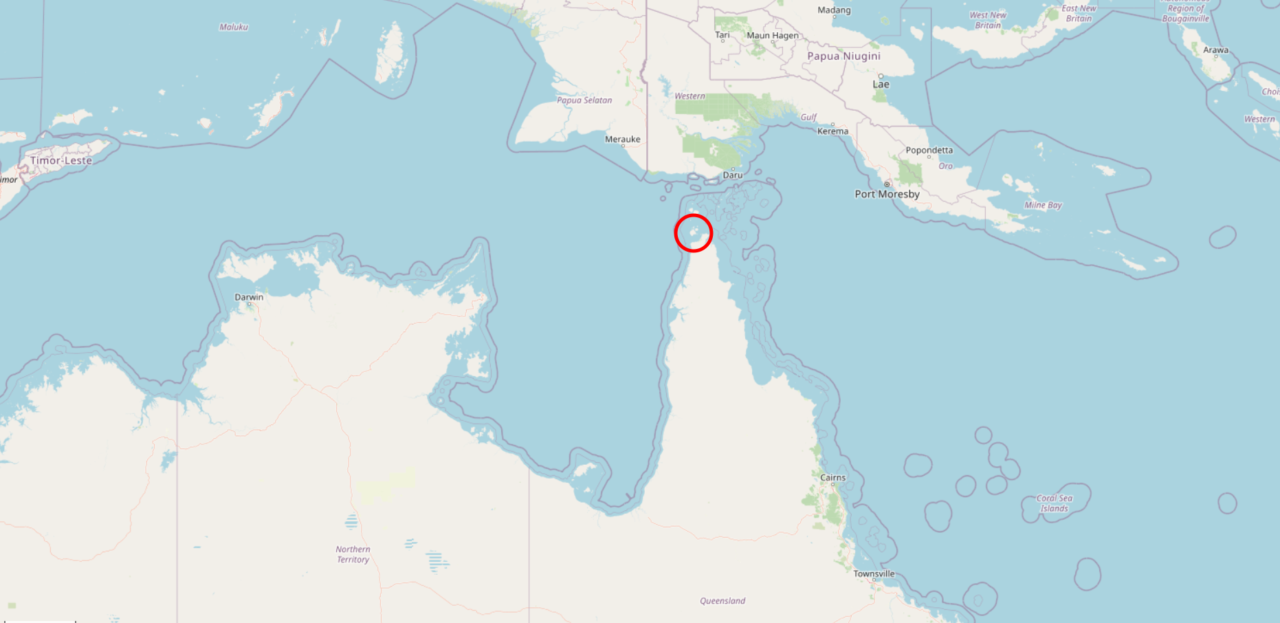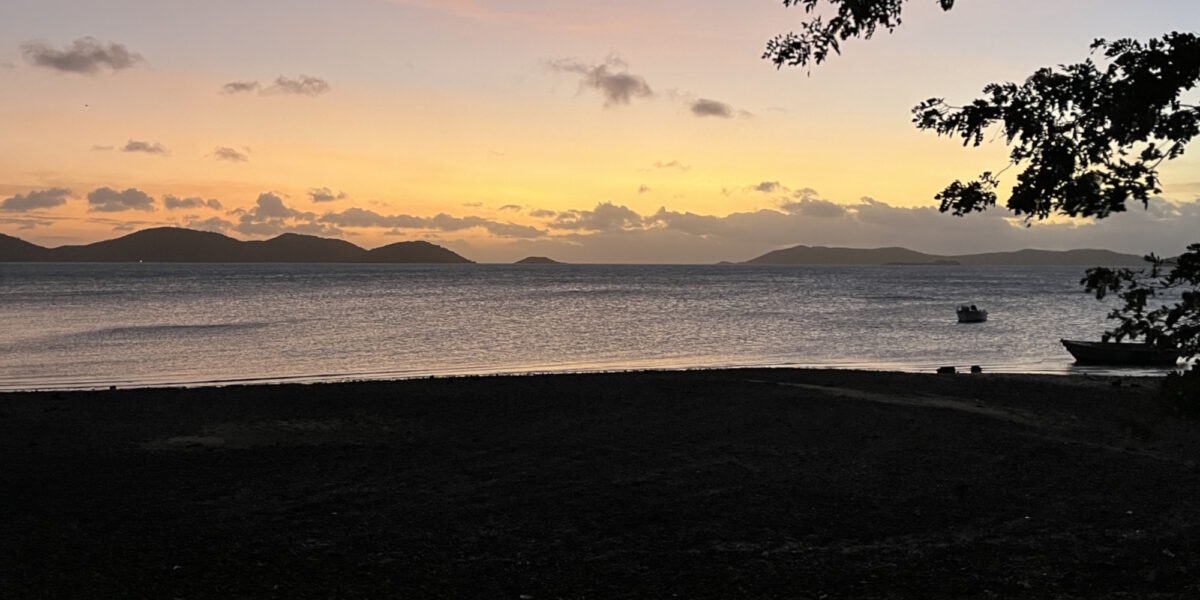Oh hurray, an early rise on a Monday morning. But it was exciting. Having gathered eight family members together in Cairns, we were getting down to the real business of this holiday.
We had a taxi booked for 6:50am (beating the theoretical 7am rush, on advice from the hotel reception staff) to the airport.
Then we boarded a plane heading about as north you can go while still being in Australia: QF 2488 from Cairns to Horn Island.

The flight was operated by a Dash 8 propeller aircraft – not a tiny plane thankfully (that would make me pretty nervous) – it’s got 74 seats.
There didn’t seem to be many tourists on the flight, though it was pretty full. A number of people in high-vis appeared to be Fly-In Fly-Out workers – there’s only two or three flights per day, so the Monday Morning flight would be the logical flight in.
The flight is just under two hours. As we descended, we passed over our actual destination… note the turbulence!
Coming off the plane at Horn Island, it was warm like Cairns… and of course completely unlike home in Melbourne in winter.
| 8th July 2024 | Melbourne | Horn Island |
| Minimum temperature | 3.5 | 24.2 |
| Maximum temperature | 16.6 | 29.8 |
| Rain | 0 mm | 0.2 mm |
Horn Island airport is pretty small. Two runways and one fairly small terminal building. Checked luggage is delivered on a cart out to the front of the terminal.
After collecting luggage we boarded a coach, which takes you to the wharf. Then there’s a short boat journey on a ferry that looked too small – and it was – they had a second one for all the luggage.
It was breezy, but the sun was shining, and it was gloriously warm.
We had, in a sense, come home.
Waiben / Thursday Island
What we now know as Thursday Island (TI for short, or the native name Waiben) has been populated for a long time.
The Brits gave it the English name of course, initially Friday Island, before names were swapped around in 1855 so east-west the islands presumably originally named on consecutive days would be Wednesday, Thursday and Friday.
In 1884 the pearl trade took off. Apart from jewellery, they were often used to make buttons.
Sometime around 1900 (we don’t know exactly when) my paternal grandfather came to Australia from China, and ended up on TI.
We know him as Chong, but this is due to the white practice of mangling Chinese names. That was really an Anglicisation of his surname.
It happened to a lot of Chinese immigrants. This means many family names with more than one syllable are probably incorrect. (Some of my Chinese Australian relatives like to point out that if you have a two syllable surname it means your family have been in Australia for longer.)
Chong bought a shop in 1910. In 1913 the How Kee family moved up from the mainland. Chong met the eldest daughter Gertrude, and they got married in 1915.
They had 7 children on TI, though sadly only 4 made it to adulthood.
To step off a boat onto a wharf and then walk onto an island where your grandparents met and married and your dad and your aunt and uncles grew up long before you were born is quite an experience. A little bit surreal. But lovely; enough to give me a warm inner glow.
The shining sun and the warm weather probably helped with that.
Even the seawater was that idyllic tropical island colour. (But it’s not great for swimming, thanks to sharks, crocodiles and stingers.)
We’d booked the trip through a local tour organiser, and were met on the wharf and given a warm welcome by Fraser, took care of the luggage.
We strolled around for a few minutes before heading up to The Grand Hotel, which is on the waterfront, for lunch.
It was very breezy, with the wind constantly threatening to topple or send flying menus or napkins or even half-empty drinks if not held down.
But it was a good meal and a good chat with Fraser, before we were met by Dirk, one of the local taxi drivers, who took us on a quick tour of the island to get us oriented.
This included going past the cemetery, and a quick stop at Green Hill Fort to admire the views. The fort was built in the 1890s to defend from the Russians – similar to Fort Queenscliff back home near Melbourne.
Here’s a photo my aunt took, which she entitled “Tempting Fate”.
The views in all directions were outstanding.
After settling into the apartments, most of us went off exploring in different directions, finding:
- the main street, Douglas Street;
- the supermarket – under the “IBIS” name (Islander Board of Industry & Service) but apparently affiliated with Woolworths;
- other shops such as Mitre 10, Col Jones (a small department store) and Mona’s Bazaar (clothes/gift shop) – all also run by IBIS
- the post office – which was able to sell me postcards and stamps, though only had a few of the latter thanks to a cruise ship coming through a few days earlier
- …and the sites of the former Metropole Hotel and Victoria Institute, notable in old family photos
I don’t think I’ve ever been to such a remote town before.
Most towns in SE Australia are readily accessible from many directions via road and/or rail. This one just isn’t. And there’s the dust, the lack of traffic and traffic lights (there’s a couple of zebra crossings only).
But it’s still recognisably Australia, thanks to things like the prominent branding of Australia Post and Mitre 10, and the Telstra pay phones in the street.
And like the rest of the country, it’s multi-cultural. It shouldn’t be a surprise to learn that there’s a proportionately larger indigenous population than in Melbourne. But as we were to learn, generations of Chinese, Malay, Anglo and lots of others have mixed over decades, so blended families and combined cultural traditions are common.
We’d been warned that only Telstra mobile works on TI. No Optus or TPG/Vodafone here. The Telstra signal was strong, thanks to towers up high on a hill elsewhere on the island.
An indigenous cultural event we’d hoped to attend fell through, so in the evening we ended up having a barbecue on the beach with Fraser and his wife, watching the sun go down.
They didn’t have to do that – we could have just gone to one of the pubs – but it was a taste of the welcoming nature of the Torres Strait.









9 replies on “That’s not north! This is north.”
The number of syllables in Chinese surnames is irrelevant to the family’s history away from China. Most surnames (thousands) consist of one Chinese character, therefore are transcribed into one-syllable English spelling. Some surnames, including many from ethnic minority groups, have two or more characters, and are therefore transcribed into English spelling with multiple syllables. There are 56 ethnic groups in China, with the main group of Han. The other 55 are ethnic minority groups. It is worth noting that in Mainland China, married ladies don’t change surnames, but in Hong Kong Special Administrative Region, married ladies prefix her original surname with her husband’s surname. They are not real multi-character surnames.
Wow, what a trip! This was great to read, and so interesting. I love that photo, ‘Tempting fate’!
@Tramologist
it does actually tend to be more common the further back you go due to clerical error. i have a friend whose ancestors immigrated to the then british colony of mauritius in the 19th century and his last name is literally the full chinese name of his great-great-grandfather. likewise you can find many newsreels up to the 1940s where writers mistakenly took a given name as a surname (e.g. chiang kai shek being referred to as ‘president kai shek’). my own chinese surname is apparently cheung or something but has been butchered and eventually scrubbed from history through loss of culture and assimilation
How interesting to have family connections to Thursday Island. I remember my sister took a group of students there about a decade ago. She met a well known Sikh man, but I forget what he was known for. Food related?
I know what you mean about being in a place of where your ancestors walked and it feeling surreal, as I felt on Strand, London.
Thanks for the comments. I’m not going to claim I know a lot about this, but I should probably qualify that I’ve heard the view about single vs multiple syllable Chinese names in the context of Australian Chinese who have been here for a generation or two…and it sounds like it was a problem elsewhere too.
Interesting that double-barrelled names are the convention in HK for married women.
What a great tale. Amazing that your family has such a fascinating history. Very interesting.
Interesting that there’s demand for such a large aircraft flying to Thursday Is. – the only time I’ve been on a Dash-8 was Melbourne-Canberra.
@Tramologist
I think you misunderstand what Daniel is saying about two syllable Chinese names usually being from older families.
As you stated, most Chinese surnames are one syllable, however Chinese first names are very often two syllables.
When the first wave of Chinese immigrated to Australia in the late nineteenth century, the Australian government did not understand the Asian concept of surname first, given name last. So when Daniel’s grandfather CHONG Quin Lem came to Australia, the authorities thought that his family name “Chong” was his first name and his given name “Quin Lem” was his surname. So Daniel’s family have wrong been going by the family name Quinlem ever since.
Other early immigrants in our extended family that had the same problem are…
TAM Gee Kee (the Gee Kee Family)
TAM How Kee (the How Kee Family)
LUM See Kee (the See Kee Family)
LUM Sue San (the Sue San Family)
TAM See Poy (the See Poy Family)
When the second wave of Chinese arrived in the 20s to 40s, the government finally realised their mistake, and these families have regular one syllable names. In Far North Queensland, these later Chinese have names like…
LEE
WONG
KWONG
CHEUNG
LAU
So as Daniel said, in Australia a Chinese person who has a two syllable surname is usually from a family who came much earlier to Australia.
Danie I have enjoyed reading your blogs on TI. I live here now as a teacher. The multicultural history of this island is truly fascinating. Then we have the opportunity unrecorded stories of the traditional owners and such as your families. My mind boggles at the richness of it all. In an island of 4square kilometres!
@Guy, thanks for the comment. We really enjoyed our visit. Even aside from our family connections, a fascinating special place.